Abstract
Changes of denervation in the anal sphincter striated and smooth muscle in patients with neurogenic faecal incontinence are well established. This study aimed to determine if there is also a more proximal visceral autonomic abnormality. Thirty women with purely neurogenic faecal incontinence (prolonged pudendal nerve latencies and an intact sphincter ring) and 12 patients with neuropathic changes together with an anatomical disruption were studied. Two control groups consisted of 18 healthy volunteer women and 17 women with normal innervation but an anatomically disrupted sphincter. Rectal sensation was assessed using balloon distension and electrical mucosal stimulation, and anal sensation by electrical stimulation. Rectal compliance was studied to determine whether sensory changes were primary or caused by altered rectal wall viscoelastic properties. Anal canal pressure changes in response to both rectal distension and rectal electrical stimulation were measured to assess the intrinsic innervation of the internal anal sphincter. Patients with neurogenic incontinence alone had impaired rectal sensation to distension (53.1 v 31.5 ml, p < 0.05, neurogenic v controls) and to electrical stimulation (24.4 v 14.8 mA, p < 0.005). Patients with neurogenic incontinence and sphincter disruption also showed impaired sensation compared with healthy controls (55.8 ml v 31.5 ml, p < 0.05 and 22.9 mA v 14.8 mA, p < 0.05). Patients with only a disrupted sphincter had normal visceral sensation to both types of testing. Both rectal compliance and the response of the internal anal sphincter to rectal distension and electrical stimulation were normal in all patient groups. This study suggests that there is a visceral sensory abnormality in patients with neurogenic incontinence which is not caused by altered rectal compliance. As evaluated in this study the intrinsic innervation of the internal anal sphincter is not affected in this process.
Full text
PDF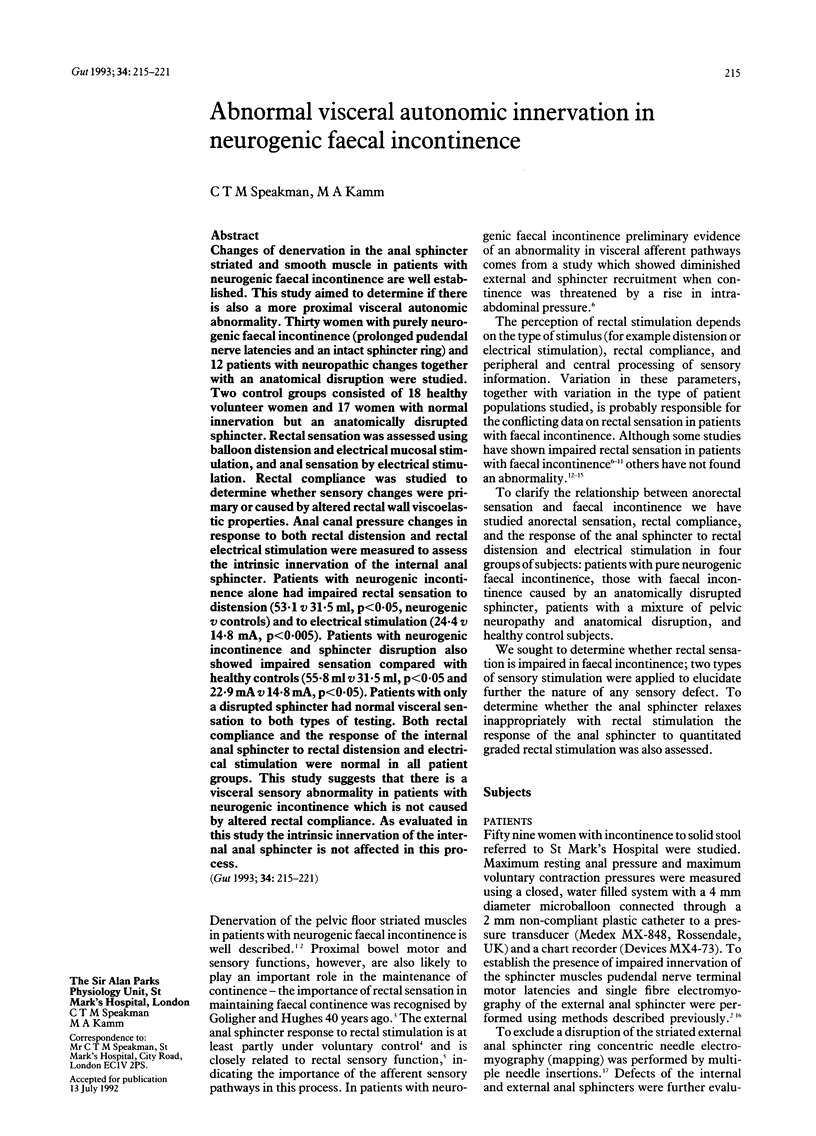
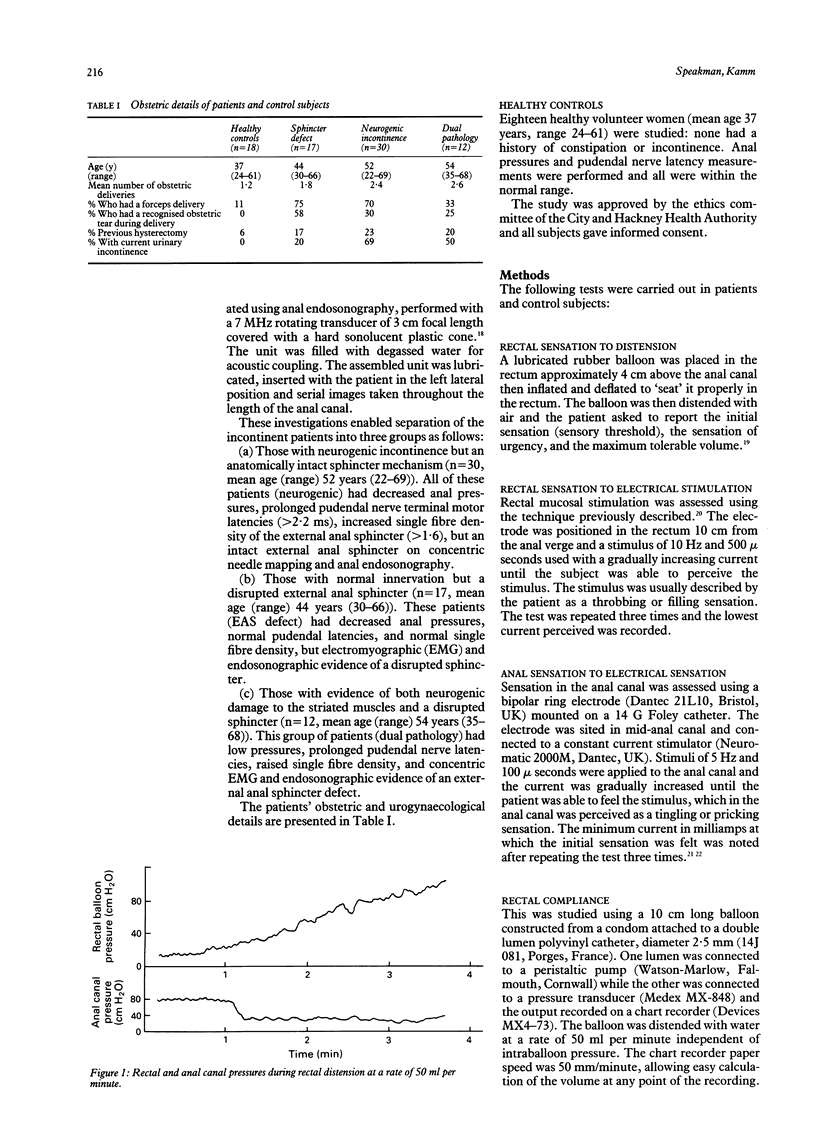
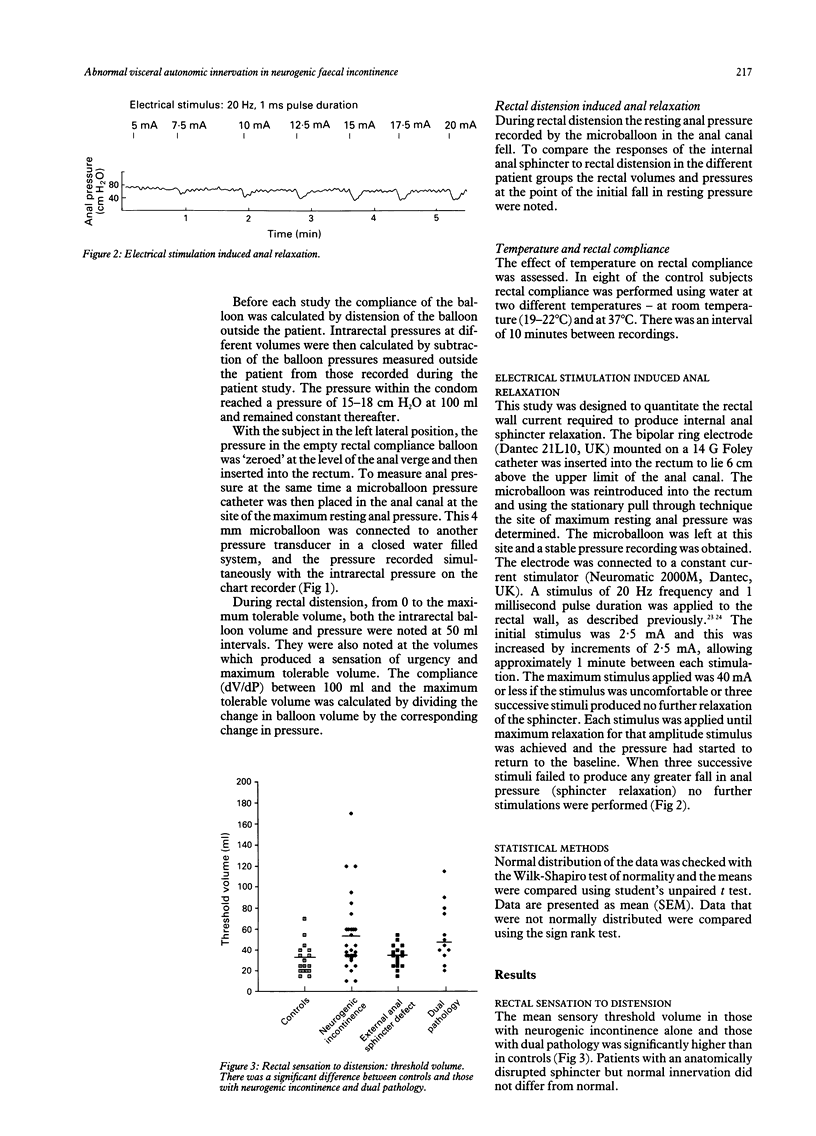

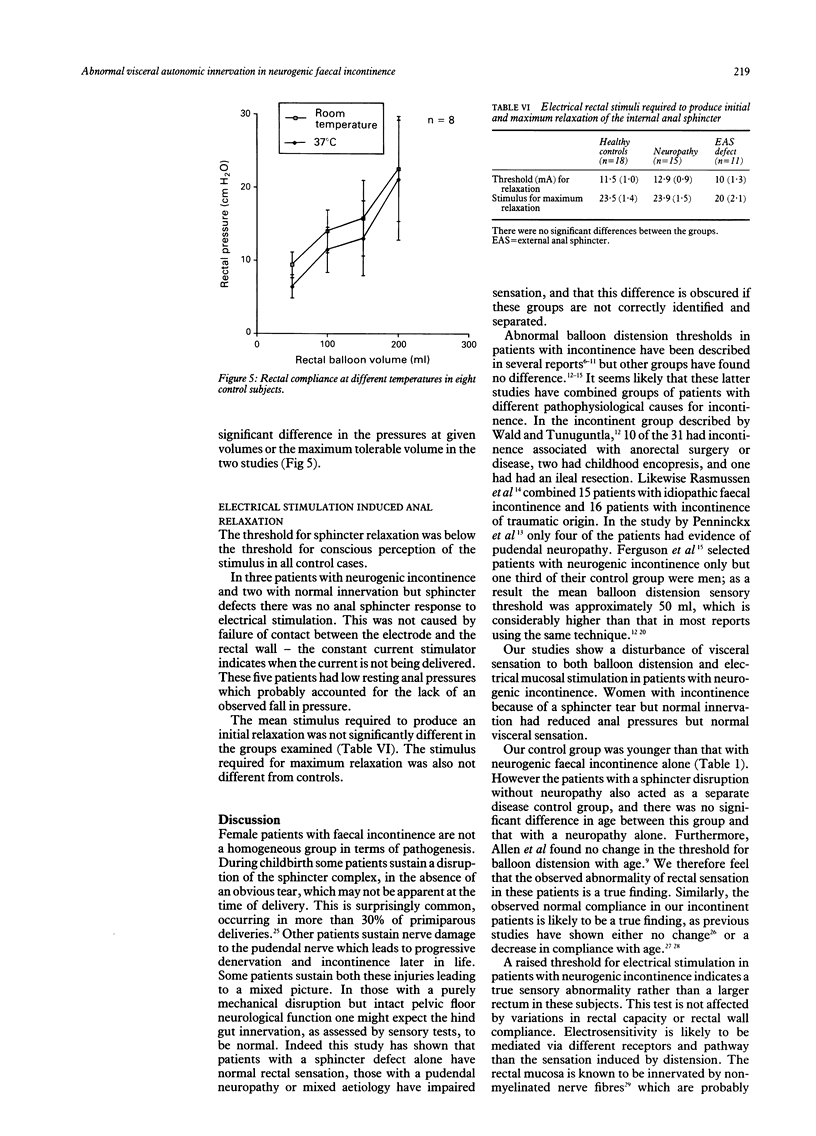
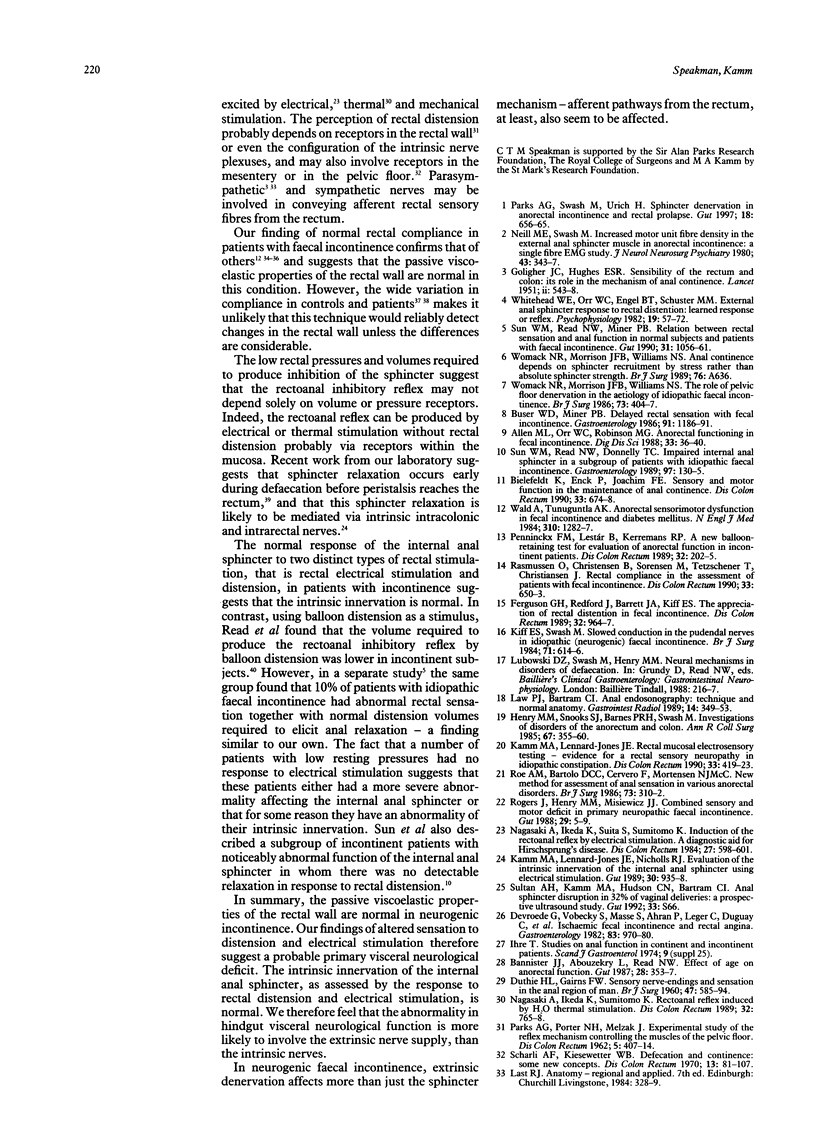
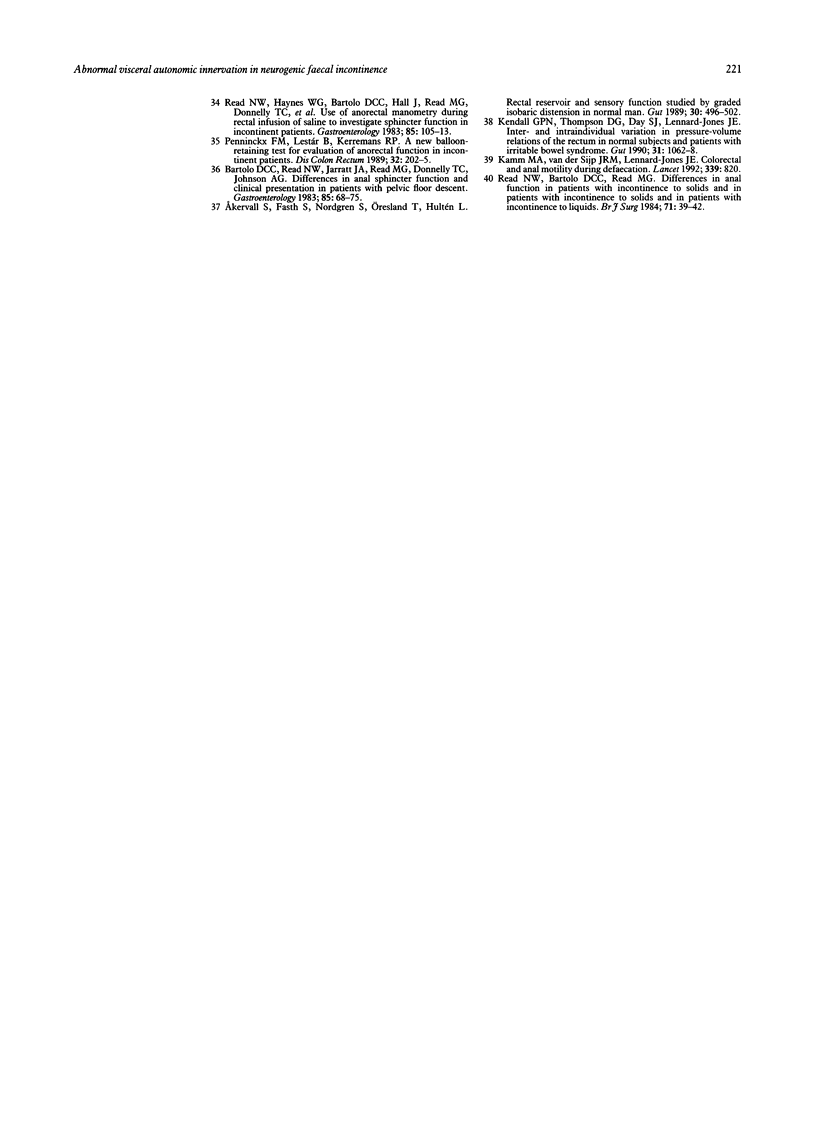
Selected References
These references are in PubMed. This may not be the complete list of references from this article.
- Akervall S., Fasth S., Nordgren S., Oresland T., Hultén L. Rectal reservoir and sensory function studied by graded isobaric distension in normal man. Gut. 1989 Apr;30(4):496–502. doi: 10.1136/gut.30.4.496. [DOI] [PMC free article] [PubMed] [Google Scholar]
- Allen M. L., Orr W. C., Robinson M. G. Anorectal functioning in fecal incontinence. Dig Dis Sci. 1988 Jan;33(1):36–40. doi: 10.1007/BF01536628. [DOI] [PubMed] [Google Scholar]
- Bannister J. J., Abouzekry L., Read N. W. Effect of aging on anorectal function. Gut. 1987 Mar;28(3):353–357. doi: 10.1136/gut.28.3.353. [DOI] [PMC free article] [PubMed] [Google Scholar]
- Bartolo D. C., Read N. W., Jarratt J. A., Read M. G., Donnelly T. C., Johnson A. G. Differences in anal sphincter function and clinical presentation in patients with pelvic floor descent. Gastroenterology. 1983 Jul;85(1):68–75. [PubMed] [Google Scholar]
- Bielefeldt K., Enck P., Erckenbrecht J. F. Sensory and motor function in the maintenance of anal continence. Dis Colon Rectum. 1990 Aug;33(8):674–678. doi: 10.1007/BF02150743. [DOI] [PubMed] [Google Scholar]
- Buser W. D., Miner P. B., Jr Delayed rectal sensation with fecal incontinence. Successful treatment using anorectal manometry. Gastroenterology. 1986 Nov;91(5):1186–1191. doi: 10.1016/s0016-5085(86)80015-4. [DOI] [PubMed] [Google Scholar]
- DUTHIE H. L., GAIRNS F. W. Sensory nerve-endings and sensation in the anal region of man. Br J Surg. 1960 May;47:585–595. doi: 10.1002/bjs.18004720602. [DOI] [PubMed] [Google Scholar]
- Devroede G., Vobecky S., Massé S., Arhan P., Léger C., Duguay C., Hémond M. Ischemic fecal incontinence and rectal angina. Gastroenterology. 1982 Nov;83(5):970–980. [PubMed] [Google Scholar]
- Ferguson G. H., Redford J., Barrett J. A., Kiff E. S. The appreciation of rectal distention in fecal incontinence. Dis Colon Rectum. 1989 Nov;32(11):964–967. doi: 10.1007/BF02552274. [DOI] [PubMed] [Google Scholar]
- GOLIGHER J. C., HUGHES E. S. R. Sensibility of the rectum and colon. Its rôle in the mechanism of anal continence. Lancet. 1951 Mar 10;1(6654):543–547. doi: 10.1016/s0140-6736(51)92242-8. [DOI] [PubMed] [Google Scholar]
- Henry M. M., Snooks S. J., Barnes P. R., Swash M. Investigation of disorders of the anorectum and colon. Ann R Coll Surg Engl. 1985 Nov;67(6):355–360. [PMC free article] [PubMed] [Google Scholar]
- Kamm M. A., Lennard-Jones J. E., Nicholls R. J. Evaluation of the intrinsic innervation of the internal anal sphincter using electrical stimulation. Gut. 1989 Jul;30(7):935–938. doi: 10.1136/gut.30.7.935. [DOI] [PMC free article] [PubMed] [Google Scholar]
- Kamm M. A., Lennard-Jones J. E. Rectal mucosal electrosensory testing--evidence for a rectal sensory neuropathy in idiopathic constipation. Dis Colon Rectum. 1990 May;33(5):419–423. doi: 10.1007/BF02156270. [DOI] [PubMed] [Google Scholar]
- Kamm M. A., van der Sijp J. R., Lennard-Jones J. E. Colorectal and anal motility during defaecation. Lancet. 1992 Mar 28;339(8796):820–820. doi: 10.1016/0140-6736(92)91957-a. [DOI] [PubMed] [Google Scholar]
- Kendall G. P., Thompson D. G., Day S. J., Lennard-Jones J. E. Inter- and intraindividual variation in pressure-volume relations of the rectum in normal subjects and patients with the irritable bowel syndrome. Gut. 1990 Sep;31(9):1062–1068. doi: 10.1136/gut.31.9.1062. [DOI] [PMC free article] [PubMed] [Google Scholar]
- Kiff E. S., Swash M. Slowed conduction in the pudendal nerves in idiopathic (neurogenic) faecal incontinence. Br J Surg. 1984 Aug;71(8):614–616. doi: 10.1002/bjs.1800710817. [DOI] [PubMed] [Google Scholar]
- Law P. J., Bartram C. I. Anal endosonography: technique and normal anatomy. Gastrointest Radiol. 1989 Fall;14(4):349–353. doi: 10.1007/BF01889235. [DOI] [PubMed] [Google Scholar]
- Nagasaki A., Ikeda K., Suita S., Sumitomo K. Induction of the rectoanal reflex by electric stimulation. A diagnostic aid for Hirschsprung's disease. Dis Colon Rectum. 1984 Sep;27(9):598–601. doi: 10.1007/BF02553850. [DOI] [PubMed] [Google Scholar]
- Nagasaki A., Ikeda K., Sumitomo K. Rectoanal reflex induced by H2O thermal stimulation. Dis Colon Rectum. 1989 Sep;32(9):765–768. doi: 10.1007/BF02562125. [DOI] [PubMed] [Google Scholar]
- Neill M. E., Swash M. Increased motor unit fibre density in the external anal sphincter muscle in ano-rectal incontinence: a single fibre EMG study. J Neurol Neurosurg Psychiatry. 1980 Apr;43(4):343–347. doi: 10.1136/jnnp.43.4.343. [DOI] [PMC free article] [PubMed] [Google Scholar]
- PARKS A. G., PORTER N. H., MELZAK J. Experimental study of the reflex mechanism controlling the muscle of the pelvic floor. Dis Colon Rectum. 1962 Nov-Dec;5:407–414. doi: 10.1007/BF02616644. [DOI] [PubMed] [Google Scholar]
- Parks A. G., Swash M., Urich H. Sphincter denervation in anorectal incontinence and rectal prolapse. Gut. 1977 Aug;18(8):656–665. doi: 10.1136/gut.18.8.656. [DOI] [PMC free article] [PubMed] [Google Scholar]
- Penninckx F. M., Lestár B., Kerremans R. P. A new balloon-retaining test for evaluation of anorectal function in incontinent patients. Dis Colon Rectum. 1989 Mar;32(3):202–205. doi: 10.1007/BF02554528. [DOI] [PubMed] [Google Scholar]
- Penninckx F. M., Lestár B., Kerremans R. P. A new balloon-retaining test for evaluation of anorectal function in incontinent patients. Dis Colon Rectum. 1989 Mar;32(3):202–205. doi: 10.1007/BF02554528. [DOI] [PubMed] [Google Scholar]
- Rasmussen O., Christensen B., Sørensen M., Tetzschner T., Christiansen J. Rectal compliance in the assessment of patients with fecal incontinence. Dis Colon Rectum. 1990 Aug;33(8):650–653. doi: 10.1007/BF02150739. [DOI] [PubMed] [Google Scholar]
- Read N. W., Bartolo D. C., Read M. G. Differences in anal function in patients with incontinence to solids and in patients with incontinence to liquids. Br J Surg. 1984 Jan;71(1):39–42. doi: 10.1002/bjs.1800710112. [DOI] [PubMed] [Google Scholar]
- Read N. W., Haynes W. G., Bartolo D. C., Hall J., Read M. G., Donnelly T. C., Johnson A. G. Use of anorectal manometry during rectal infusion of saline to investigate sphincter function in incontinent patients. Gastroenterology. 1983 Jul;85(1):105–113. [PubMed] [Google Scholar]
- Roe A. M., Bartolo D. C., Mortensen N. J. New method for assessment of anal sensation in various anorectal disorders. Br J Surg. 1986 Apr;73(4):310–312. doi: 10.1002/bjs.1800730421. [DOI] [PubMed] [Google Scholar]
- Rogers J., Henry M. M., Misiewicz J. J. Combined sensory and motor deficit in primary neuropathic faecal incontinence. Gut. 1988 Jan;29(1):5–9. doi: 10.1136/gut.29.1.5. [DOI] [PMC free article] [PubMed] [Google Scholar]
- Scharli A. F., Kiesewetter W. B. Defecation and continence: some new concepts. Dis Colon Rectum. 1970 Mar-Apr;13(2):81–107. doi: 10.1007/BF02617635. [DOI] [PubMed] [Google Scholar]
- Sun W. M., Read N. W., Donnelly T. C. Impaired internal anal sphincter in a subgroup of patients with idiopathic fecal incontinence. Gastroenterology. 1989 Jul;97(1):130–135. doi: 10.1016/0016-5085(89)91425-x. [DOI] [PubMed] [Google Scholar]
- Sun W. M., Read N. W., Miner P. B. Relation between rectal sensation and anal function in normal subjects and patients with faecal incontinence. Gut. 1990 Sep;31(9):1056–1061. doi: 10.1136/gut.31.9.1056. [DOI] [PMC free article] [PubMed] [Google Scholar]
- Wald A., Tunuguntla A. K. Anorectal sensorimotor dysfunction in fecal incontinence and diabetes mellitus. Modification with biofeedback therapy. N Engl J Med. 1984 May 17;310(20):1282–1287. doi: 10.1056/NEJM198405173102003. [DOI] [PubMed] [Google Scholar]
- Whitehead W. E., Orr W. C., Engel B. T., Schuster M. M. External anal sphincter response to rectal distention: learned response or reflex. Psychophysiology. 1982 Jan;19(1):57–62. doi: 10.1111/j.1469-8986.1982.tb02599.x. [DOI] [PubMed] [Google Scholar]
- Womack N. R., Morrison J. F., Williams N. S. The role of pelvic floor denervation in the aetiology of idiopathic faecal incontinence. Br J Surg. 1986 May;73(5):404–407. doi: 10.1002/bjs.1800730531. [DOI] [PubMed] [Google Scholar]


